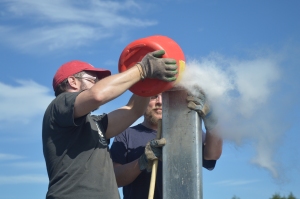
Post by Simon Goring, Postdoc at the University of Wisconsin-Madison.
This post originally appeared at downwithtime.
We’re at Camp PalEON this week. It’s lots of fun and I think that the attendees get a lot out of it. Effectively we’re trying to distill process associated with the entire seven year project into one week of intensive learning. We teach probability theory, Bayesian methods, ecosystem modelling, dendrochronology, paleoecology and pollen analysis, age modelling and vegetation reconstruction to seventeen lucky early-career researchers in six intensive days (people were still plunking away at 11pm last night, our first day!).
We spend a lot of our time at the University of Notre Dame’s Environmental Research Center indoors looking at computers, but we had a very nice time yesterday afternoon. I hung out on a raft with Jack Williams and Jason McLachlan, coring with a frozen finger. The frozen finger is a special kind of corer, used to recover lake sediment that preserves the sediment stratigraphy in a much cleaner way than many other coring techniques.

Jack Williams and Jason McLachlan filling the core casing with ethanol so that the cold slurry conducts to the outer wall. (photo credit: Jody Peters)
When using the frozen finger we fill the base of the corer with dry ice, and suspend the dry ice in ethanol to create an incredibly cold surface. We then drop the casing into the lake sediment. The sediment freezes to the surface of the core casing over the course of ten or fifteen minutes before we pull the corer back to the surface of the lake. The freeze-corer (or frozen finger) is often used for ancient DNA studies (e.g., Anderson-Carpenter et al., 2011) since the freezing process helps stabilize DNA in the lake sediment until the core can be brought back to the lab and analyzed.

The sediment on the outside of the core casing is peeled off carefully and wrapped before it is stored in a cooler of dry ice. (photo credit: Jody Peters)
Jason McLachlan and I are going to go sieve the sediment ourselves later this afternoon to give the workshop participants a chance to take a look at lake sediment, pick charcoal and find macrofossils later tonight. Meanwhile everyone is hard-coding an MCMC model in R and, later today, learning about Midwestern Paleoecology. All in all, it’s a great course and I’m happy to be involved with it for a second time. Hopefully we’ll have some more posts, but in the meantime we’ve made the preliminary readings open to the public on our project wiki, and most of our R work is up and available on GitHub so that you can take a look and work along.
